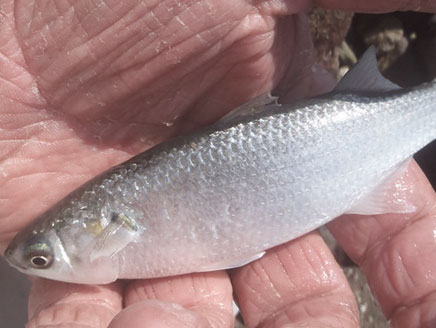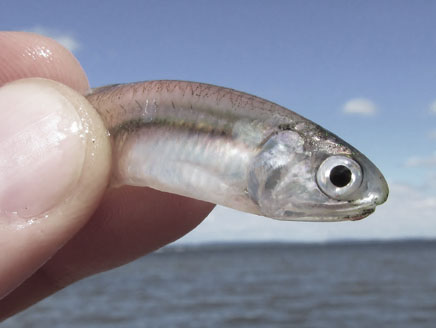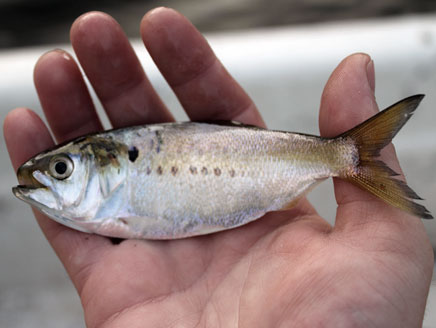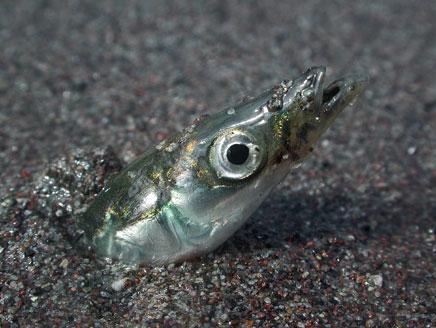

During the fabled "Fall Run", Striped Bass and Chomper Blues are not the only fish on the move...
by Tom Vassallo
The fabled "Fall Run" is nearly here and reports of stripers in the surf are getting New Jersey anglers excited. Many of these "fin-atics" haven't paid much attention to striper fishing since the spring migration of bunker and monster cows were moving by, headed to their spawning grounds in the major bays and rivers of the Northeast. They may stop for a meal or two on migrating spring bunker until they quickly abandon us here at the Jersey shore for the cooler waters off of New England. But, about the time you are reading this, our fickle finned friends are getting ready to head back down south to their wintering grounds off of the Carolinas...and many of us can't wait to get back on them as soon as they start passing by the beaches of the Jersey Shore.
 |
| Mullet are one of the first baitfish that get moving in the fall and striped bass find many in September as they forage for food prior to and during the Fall Run. |
The spring migration always seems to happen too quickly here in Jersey. That may be because the fish in the spring are concentrating on the important business of the spring season...the spawn. After these migrating bass leave the winter areas around North Carolina and Virginia, the majority of them (estimated to be 70%!) are headed for the Chesapeake Bay. Others head for the major spawning grounds of the Delaware River, Hudson River and finally the Massachusetts and Cape Cod Bays. (So I thought we were going to discuss finding the fish?) Well now that you've got the picture of how they move in the spring, let's take a look at one of the major factors that drives the "Fall Run"...not just the bass themselves...but the bait they are following.
 |
| Believe it or not, the "rainfish" or bay anchovy is the most prevalent fish in the bays of New Jersey. Millions of these little guys will become a meal for predator fish during both the summer and fall. |
Take all those bass that have done their spawning in the river and bay waters and are now residing off the coast of New England...well, they like water temperatures between 55 to 68 degrees. So with fall and winter moving in, those northern waters are the first to exhibit dropping temperatures. The shallower waters of the northern bays begin to cool much more quickly than the ocean temps. So as those cooler waters feed into our New England coast, this will trigger the exodus of menhaden (bunker) from their northern summering areas. Adult and juvenile menhaden will form large, near-surface schools, primarily in estuaries and near shore ocean waters from early spring through the fall and early winter. But with the cooling of the bays, during fall-early winter, menhaden of most sizes and ages migrate south around the North Carolina capes to spawn. Well in order to get to the Carolinas, they've got to pass by the New Jersey shore! Sound familiar? Sounds an awful lot like striped bass behavior.
However, even before the menaden run by the beach, another important bait species will head out...the "finger mullet". Specifically, in New Jersey the species that attract the local and resident bass are "Mugil cephalus". Many of us know them as "striped mullet". Cast netters lucky enough to net some of the mullet and keep them in an aerated tank, can fish them alive by hooking them through the dorsal fin and live lining the baitfish. Should you just keep them on ice in a cooler, the fresh mullet will out fish any other baitfish for both bluefish and smaller stripers usually happening after the second or third week of September. Interestingly, many feel that the mullet migration is not triggered by the water temperature, but by lunar phases. It seems that regardless of water temperature, the phases of the moon may trigger the migration of the mullet in late September, as well as the migration of the young, year old menhaden or "peanut bunker" in October and November.
 |
| The "peanut bunker" is simply a juvenile menhaden. As these fish school up in the shallow estuary waters, they will be hunted by larger juvenile bass. When locating a school of these in backwaters, be advised that the bass are there too! |
But the primary fish found in our New Jersey bays when fish surveys are conducted are not the big game fish. Believe it or not, the top population always consists of a small fish which many of us call a "rainfish". In reality, the rainfish is actually a "bay anchovy". These fish primarily spend most of their lives in the bays, but the larger rainfish (especially in Barnegat Bay) have been shown to migrate offshore in...you guessed it...mid to late October and sometimes as late as December, depending on land and water temperatures.
Not much is known scientifically about the American Sand Launce or "sand eel" as most anglers know them. However, this little guy has been driving a lot of the late fall and early winter migration of both bass and bluefish. Information may be hard to find due to the fact that these little buggers bury themselves wholly or partially in the sand to escape their large predators. During the past year or two, a large population has taken up residence for weeks at a time off the Jersey Shore. The good news is that they love the sand and don't like deep water. Hey...surf guys...you getting this? Sand eels are a main forage fish for the "linesiders" when it's starting to get cold...so make sure you've got some for bait or at least some lures that mimic this little guy!
 |
| Not much research has been conducted on the "Sea Lance" or "Sea Launce". Commonly known as the "sand eel", they are not eels at all. They also will bury most of their body below the sea bottom to escape predators. It is no secret that stripers Love 'em! |
So I think you've got the picture...find the baitfish, "Match the Hatch" and you will inevitably find the fish. The "Fall Run" is not based on magic, but simply the natural migration of the striped bass food source, as well as the bass themselves. These fish just keep roaming until they find water temps they are comfortable in. That water is always going to be the same temps that their food source is comfortable in. So now we know how to find the fish...but how do we know when the bait will be moving. Here's the usual timetable...late September is mullet time. Mid-October you should see the rainfish and peanut bunker begin their fall migration. The larger menhaden will continue into November and in late November to December, the sand eels should be around.
To be on top of this "baitfish timetable", visit and talk to your local bait and tackle owners. They can give you all the inside scoops on the baits and sell you a supply of them as well. If they haven't got fresh bait, there are many good lures they will have in stock that will match the hot bait fish running at the particular time you are chasing those bass. Now get out there and fish!














